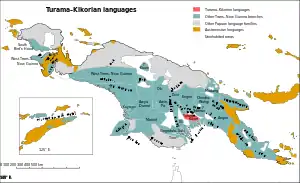Turama–Kikorian languages
The Turama–Kikorian languages are a family identified by Arthur Capell (1962) and part of the Trans–New Guinea languages (TNG) family in the classifications of Stephen Wurm (1975) and Malcolm Ross (2005). The family is named after the Turama River and Kikori River of southern Papua New Guinea; the alternative name is based more narrowly on the Omati River.
| Turama–Kikorian | |
|---|---|
| Rumu – Omati River | |
| Geographic distribution | Omati River region, Gulf Province, Papua New Guinea |
| Linguistic classification | Papuan Gulf ?
|
| Subdivisions | |
| Glottolog | tura1263 |
 Map: The Turama–Kikorian languages of New Guinea
The Turama–Kikorian languages
Trans–New Guinea languages
Other Papuan languages
Austronesian languages
Uninhabited | |
Languages
The four languages are clearly related, though Rumu is divergent. Ross states that Rumu links the other (Turama) languages to TNG.
Proto-language
Some lexical reconstructions by Usher (2020) are:[1]
gloss Proto-Rumu-Omati Proto-Omati River Rumu head/top *mab *mab mapô leaf/hair/feather *b[au]t *bɔt ?paɾâu ear *go̝ *go̝ kō eye *isĩ *isĩ ihī nose *ju *ju jū tooth *magu *magu makù foot/leg *tãᵋ *tãᵋ ɾɛ̂ bone *tab *tab ɾapò breast *sõ̝ *sõ̝ hó louse *gutɔm *gutɔm kuɾɔ̀ dog *gas *gas ká ~ kaé pig *gɔ[u]n *gɔn kɔù bird *gaᵋ *gaᵋ ká ~ kaé egg *d[ɔ]um *d[ɔ]um tree *i *i ì sun *ɛsɔa *ɛsɔa ɛhɔ̂ water *wẽ̝ *wẽ̝ fire *i *i ì path *dɛⁱ *dɛⁱ tɛî name *e̝ne̝ne̝n *ne̝ne̝n enené two *t[aⁱ/aᵋ] *taᵋ taí
Vocabulary comparison
Basic vocabulary
The following basic vocabulary words are from Franklin (1973),[2] as cited in the Trans-New Guinea database:[3]
gloss Rumu Ikobi-Mena Mena Omati head wotu rapo mapʰ mabo mawo hair pate maporo maboru mahabero ear ku pate kupi kovi kovi eye ihita si(tom) sitɔumu isi nose yu rapo bopʰ boƀo sorowu tooth maku ka̧i̧ yo kaiyɔ kokame tongue ɔhɔ kumen kumɛn komene leg re riki hae hại habo hai louse kuro kurom kuromiə kulamu dog ka kas kasə kase bird ka kae kaiɛ kae egg re tʌom tʌmɛ mena hai blood hokore kai kai kei bone rapo hap havo havo skin heitau kora kʷaru kebo breast hɔ so̧ so; šo šu tree i i ʔi man uki wane wɔnami; wɔne gamin woman wo besi bɛse bes sun eho iyos yosə; yosu soa moon pari wasiba wasibia; wasibʌŋʌ baira water u mu̧ mu fae fire i kom kumu kumu stone akapu kam kamə kamu name paina nanini nɛnɛne nenena eat nato nokun; nouwe nʌᵘwe damanai one riabai; ṛiabai sʌkanɛ sʌkanɛ sakaina two tai hae haiɛ hatarari
Fauna names
Below are some turtle names, with additional names in Porome, Kiwaian, and Kutubuan languages also provided for comparison:[4]
| Language [Location] | Emydura subglobosa | Elseya novaeguineae | Carettochelys insculpta | Pelochelys bibroni | Marine turtle |
|---|---|---|---|---|---|
| Ikobi [Kasere] (Kaiam) | Kaso bubal | Kaso bubal | Kaso Uwo | Kaso Mimiri | – |
| Foroba (Omo, Kuru) | Kinisuga | Kesoga | Buguama | Mimiri | – |
| Rumu (Kopi, Ogamabu, Irimuku, Lalau, Ario, Waira) | Kehoko | Kehoko, Purapati | Piku | Mimiri, Otohehe | – |
| Porome [Kibiri] (Veiru, Doibo) | Ketori | Ketori | Watemui | Kauri | – |
| Porome [Porome] (Ero, Wowou) | Ketoko | Ketoko | Watemu | Dabeuri | – |
| Kerewo [Goaribari] (Apeawa, Samoa) | – | Koimo[5] | Uwo[6] | Unawaya | Mirimiri, Gamo[7] |
| Kiwai, Northeast [Urama] (Veraibari) | Koimo | Koimo | Va’ema[8] | Goava’ema | Mia Mia |
| Foi (Soro, Wasami, Tugiri, Kese, Kapoi) | – | Baregwarabo | – | – | – |
| Fasu (Wairo, Hebaya) | – | Eketaiyaa | – | – | – |
Names for Emydura subglobosa and Elseya novaeguineae are generally identical or similar.
References
- Timothy Usher, New Guinea World, Proto–Rumu – Omati River
- Franklin, K.J. "Other Language Groups in the Gulf District and Adjacent Areas". In Franklin, K. editor, The linguistic situation in the Gulf District and adjacent areas, Papua New Guinea. C-26:261-278. Pacific Linguistics, The Australian National University, 1973. doi:10.15144/PL-C26.261
- Greenhill, Simon (2016). "TransNewGuinea.org - database of the languages of New Guinea". Retrieved 2020-11-05.
- Georges, A., Guarino, F., & Bito, B. (2006). Freshwater turtles of the TransFly region of Papua New Guinea – notes on diversity, distribution, reproduction, harvest and trade. Wildlife Research, 33(5), 373. doi:10.1071/wr05087
- Confirmed for Samoa Village, Aird Hills by Martin Steer.
- Confirmed for Samoa Village, Aird Hills by Martin Steer.
- Name provided by Martin Steer for Samoa Village (Kerewo), Aird Hills.
- Ma’ema has been recorded for Gope dialect, Kiwai NE language by Robert Petterson.
- Ross, Malcolm (2005). "Pronouns as a preliminary diagnostic for grouping Papuan languages". In Andrew Pawley; Robert Attenborough; Robin Hide; Jack Golson (eds.). Papuan pasts: cultural, linguistic and biological histories of Papuan-speaking peoples. Canberra: Pacific Linguistics. pp. 15–66. ISBN 0858835622. OCLC 67292782.